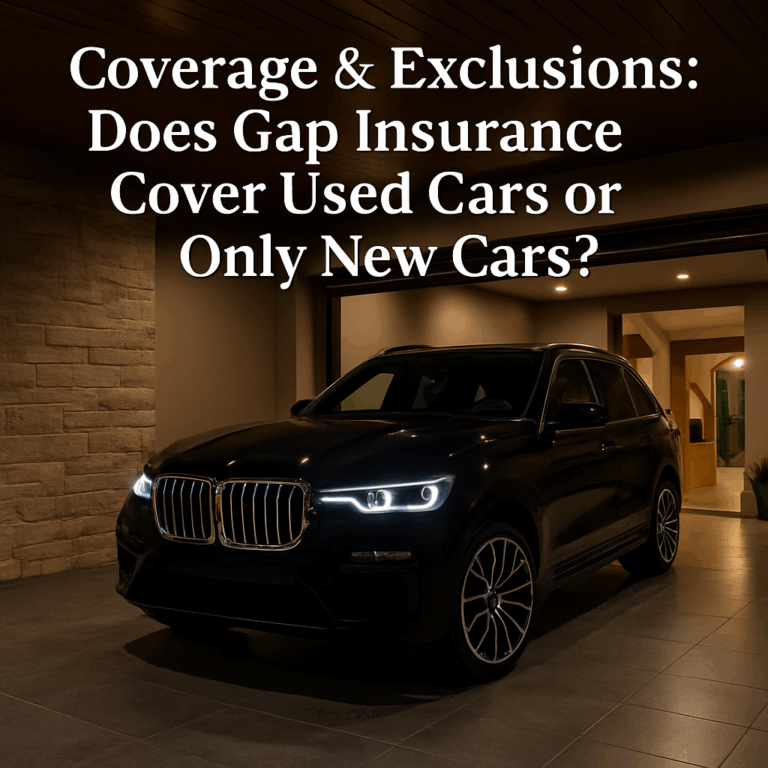Coverage & Exclusions: Does Gap Insurance Cover Used Cars or Only New Cars?
When financing a vehicle, the moment you drive it off the lot, an invisible financial gap begins to form. This gap represents the difference between the amount you owe on your loan and the vehicle’s actual market value, a value that plummets due to depreciation. If your vehicle is stolen or declared a total loss in an accident, your primary auto insurance will only pay this depreciated value. This leaves you potentially owing thousands of dollars on a car you no longer have.
This is where Guaranteed Asset Protection (GAP) insurance becomes a critical component of your financial strategy. It is designed specifically to cover this high-risk shortfall. However, the decision to purchase GAP coverage is not one-size-fits-all; the need varies significantly between new and used vehicles, and understanding the nuances is key to effective risk management.
This in-depth analysis will demystify GAP coverage, detailing its mechanics, crucial exclusions, and the distinct considerations for both new and used car buyers. We will provide a clear framework to help you determine if this protection is a necessary safeguard for your assets or an unnecessary expense.
The Core Mechanics: How GAP Insurance Fills the Financial Void
Before comparing new and used vehicles, it’s essential to understand exactly how GAP insurance functions as a secondary, supplemental policy. The process is always triggered by a “total loss” event. A vehicle is typically deemed a total loss when the cost to repair it exceeds a certain percentage (often 70-80%) of its pre-accident Actual Cash Value (ACV).
The claims process unfolds in a specific sequence:
- Primary Insurance Payout: After a total loss, you file a claim with your primary auto insurer. They calculate your vehicle’s ACV, which is its fair market value the moment before the incident, based on factors like age, mileage, condition, and regional sales data. After subtracting your deductible, the insurer sends this payout directly to your lender to be applied to the loan.
- Identifying the “Gap”: Your lender applies the insurance payout to your outstanding loan balance. If you still owe more than the payout amount, that remaining deficit is the “gap.”
- GAP Coverage Activation: You then file a second claim with your GAP provider. They verify the numbers and pay the gap (or a portion of it, depending on policy limits) directly to the lender, settling your remaining debt.
A Real-World Example: Imagine you financed a vehicle and now face a total loss.
- Your Outstanding Loan Balance: $30,000
- Vehicle’s Actual Cash Value (ACV): $26,500
- Your Collision Deductible: $1,000
- Primary Insurer’s Payout: $26,500 (ACV) – $1,000 (Deductible) = $25,500
- The Financial Gap: $30,000 (Loan) – $25,500 (Payout) = $4,500
In this scenario, your GAP insurance policy would cover the
$4,500 shortfall, saving you from significant out-of-pocket loss. It is crucial to remember that you must have comprehensive and collision coverage on your primary auto policy for GAP insurance to apply. Without this foundational coverage, GAP is void.
Crucial Exclusions: What GAP Insurance Will Not Cover
Understanding a policy’s limitations is as important as knowing its benefits. GAP insurance is a highly specialized tool and is not a catch-all solution. For both new and used cars, the following are typically excluded from coverage:
- Your Deductible: While some premium GAP products may offer to cover your deductible, the vast majority do not. You should expect to pay this amount out of pocket.
- Loan Add-Ons and Negative Equity: The portion of your loan used to finance non-vehicle items like extended warranties, service contracts, or credit life insurance is often excluded. These items add to your loan balance but not to the car’s ACV.
- Late Fees and Past-Due Payments: GAP is not designed to cover any delinquent payments, late fees, or other penalties associated with your loan.
- Non-Total Loss Repairs: If your vehicle is damaged but not declared a total loss, GAP insurance provides no benefit. All repairs are handled by your primary comprehensive or collision policy.
- Bodily Injury and Property Damage: GAP does not cover medical expenses, lost wages, or damage you cause to other people’s property. These are covered by the liability and medical portions of your primary auto policy.
- Policy Violations: If the total loss occurred under circumstances that void your primary insurance (such as DUI, illegal street racing, or unapproved commercial use), your GAP claim will also be denied.
The Case for GAP on New Cars: Battling Steep Depreciation
The need for GAP insurance is most pronounced with new vehicles due to their rapid and predictable depreciation. A new car can lose over 20% of its value within the first year of ownership, creating an immediate and significant gap between its ACV and your loan balance.
You almost certainly need GAP coverage on a new car if you:
- Made a Small Down Payment (Less than 20%): A small down payment means you are financing a very high percentage of the vehicle’s purchase price, making it highly probable that you will be “underwater” (owe more than the car is worth) for several years.
- Chose a Long Loan Term (60-84 months): Longer loan terms result in lower monthly payments, but you pay more in interest over time and build equity very slowly. During the first few years, your payments are primarily interest, while the car’s value is depreciating at its fastest rate.
- Rolled Negative Equity into the Loan: If you traded in a vehicle that was underwater and rolled that old debt into your new loan, you are starting with a significant gap from day one. This makes GAP coverage essential.
- Are Leasing the Vehicle: Lease agreements are structured around the vehicle’s depreciation. Because you are not building equity, GAP is almost always required by the leasing company, and is often built directly into the lease payments.
For new car owners, the question is less about if you need GAP, but when you can safely cancel it. Typically, after 2-3 years of payments, your loan balance will drop below the car’s ACV. At that point, you have positive equity, and GAP insurance no longer provides a benefit.
Assessing the Need for GAP on Used Cars: A Nuanced Decision
A common misconception is that GAP insurance is only for new vehicles. While used cars depreciate more slowly, the same financial principles apply, and GAP coverage functions identically. The decision to purchase it for a used car depends entirely on the specific financial details of your purchase.
You should strongly consider GAP on a used car if you:
- Financed with a Low or Zero Down Payment: Just like with a new car, a small down payment on a used vehicle can create an immediate gap, especially if you financed taxes and fees.
- Purchased a High-Depreciation Model: Some used models, particularly certain luxury sedans or older electric vehicles, may still depreciate faster than average, creating risk.
- Paid Above Market Value: In a tight market with low supply, you may have paid a premium for your used car. An insurer’s ACV calculation, however, will be based on standard market data, potentially creating a larger-than-expected gap.
- Cannot Absorb a Financial Shock: If you do not have several thousand dollars in savings to comfortably cover a potential loan shortfall after a total loss, GAP provides an affordable and predictable safety net.
Conversely, you may be able to skip GAP on a used car if a large down payment or a short-term loan means you have positive equity from the start, or if your loan balance is already well below the car’s established market value.
Strategic Sourcing: Where to Buy GAP and What to Expect
The cost and structure of GAP coverage can vary significantly depending on where you purchase it.
| Purchase Source | Pros | Cons |
| Your Auto Insurer | Inexpensive add-on to your policy | May be a “loan/lease payoff” product with a cap (e.g., 25% of ACV) |
| Convenient monthly payments | ||
| Dealership or Lender | Convenience of a one-time purchase | Significantly more expensive flat fee (hundreds of dollars) |
| Can be rolled into your auto loan | You pay interest on the GAP premium over the life of the loan |
The “loan/lease payoff” coverage offered by some insurers is a key distinction. A cap, such as 25% of the ACV, means that if your car’s ACV is $20,000, the policy will pay a maximum of $5,000 to cover the gap. If your gap is larger than that, you are responsible for the rest. Always read the fine print to understand these limitations.
A pro tip: If you purchase GAP from a dealership and later pay off your loan early, sell the car, or refinance, you are often entitled to a prorated refund for the unused portion. You must proactively contact the provider to request this, as it is rarely automatic.
Your Financial Firewall: A Final Decision Framework
Ultimately, the choice to buy GAP insurance for a new or used car is a personal risk assessment. Use this simple framework to guide your decision:
You should choose GAP if:
- Your outstanding loan payoff is greater than the vehicle’s current ACV.
- You cannot easily absorb a potential out-of-pocket loss of $2,000 to $10,000 after a total loss.
- You are leasing the vehicle (first, verify it isn’t already included).
You can likely skip (or cancel) GAP if:
- You have strong positive equity in the vehicle (loan payoff is less than ACV).
- You have the liquid savings to comfortably self-insure against the potential gap risk.
For new cars, GAP is a highly recommended tool to weather the initial storm of depreciation. For used cars, a careful analysis of your loan terms is required. In both cases, GAP insurance acts as a crucial firewall, ensuring that a total loss of your vehicle does not also become a lingering financial disaster.


